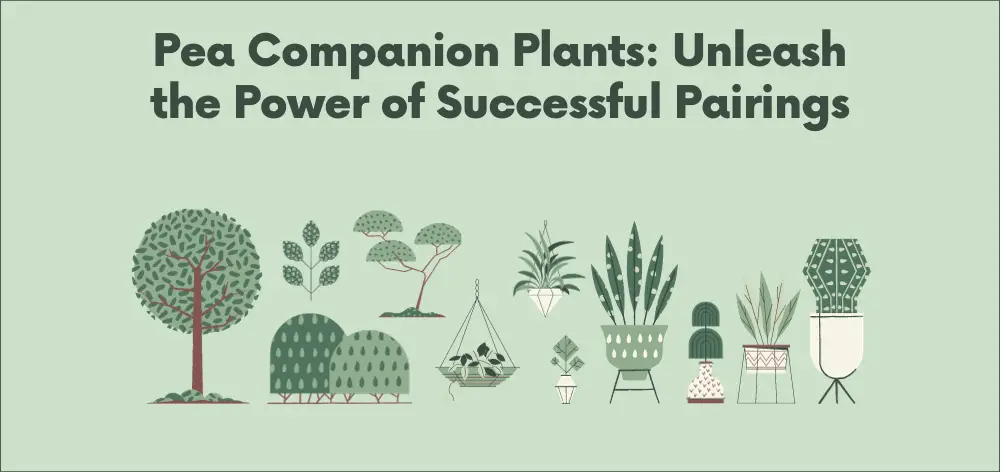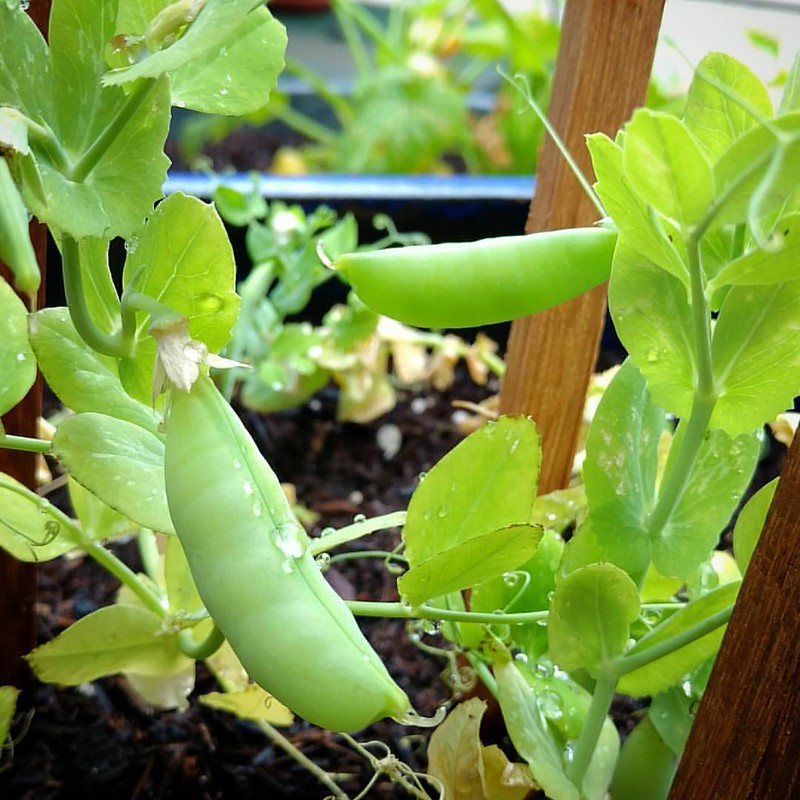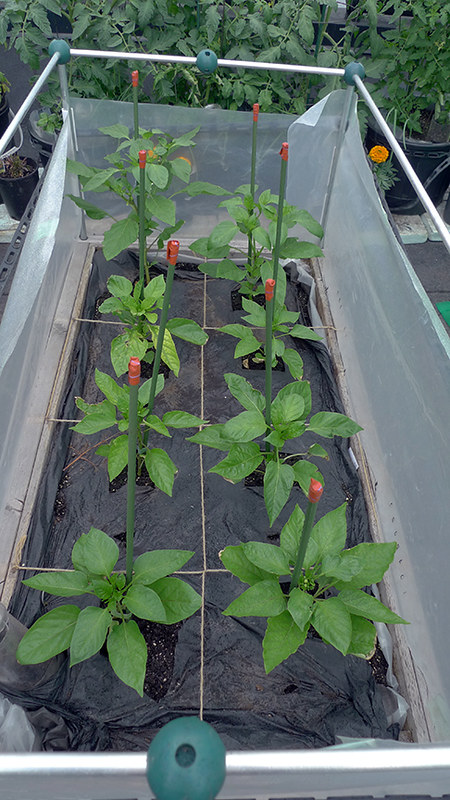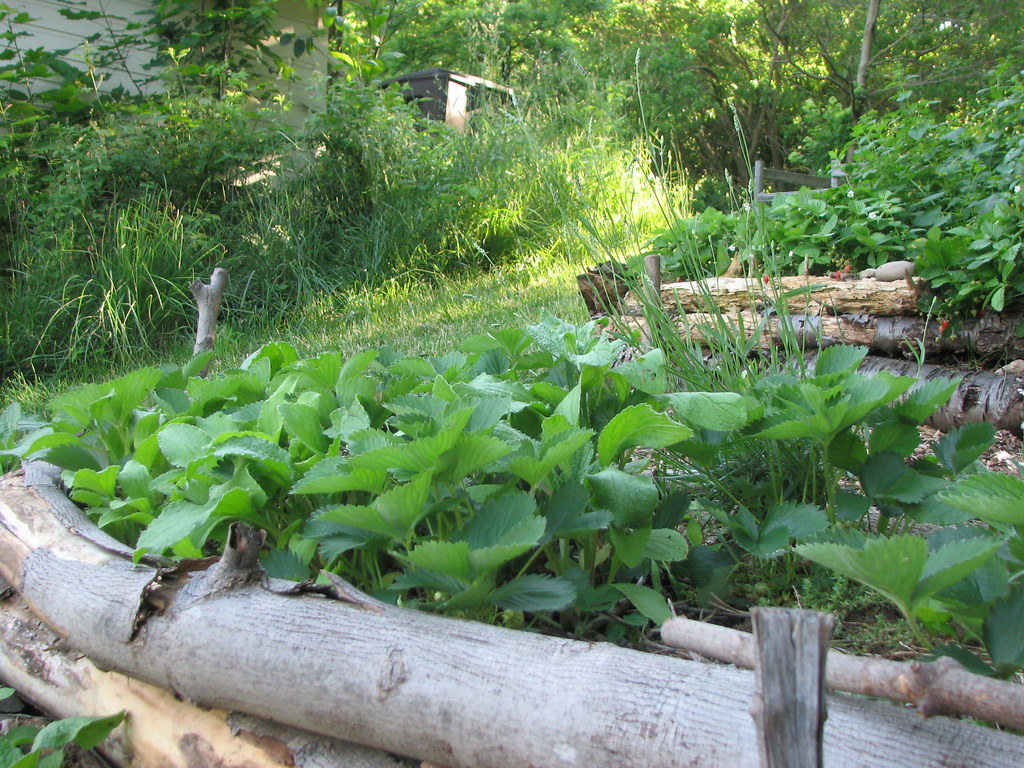Pea companion plants are beans, carrots, celery, corn, cucumber, eggplant, parsley, peppers, potatoes, radish, spinach, strawberries, and turnips. It is best to avoid planting peas near onions, garlic, leeks, shallots, scallions, and chives, as they stunt pea growth.
Onions and garlic are examples of alliums that inhibit pea growth. Companion plants from the Brassica family, such as cauliflower, Brussels sprouts, broccoli, and cabbage, are also suitable for planting with peas. Cilantro grows well with peas, especially sugar snap peas, and potatoes and eggplants are great companions for any pea variety.
Benefits Of Companion Planting With Peas
Companion planting with peas offers numerous benefits. Peas thrive when planted alongside beans, carrots, corn, cucumber, parsley, and spinach while avoiding onions and alliums. This practice helps promote healthy growth and enhances the overall yield of pea plants.
Peas are not only delicious and nutritious, but they also make excellent companions for several other plants in the garden. When you practice companion planting with peas, you can enjoy a range of benefits that will not only enhance the overall health and yield of your peas but also benefit the surrounding plants.
Let’s take a closer look at the advantages of companion planting with peas:
Promotes Healthier Growth And Yield:
- Peas are nitrogen-fixing legumes, which means they have the unique ability to convert atmospheric nitrogen into a more usable form for plants. This process helps to enrich the soil with nitrogen, promoting healthier and more vigorous growth not only for the peas but also for other plants nearby.
- Peas also have a shallow root system, which doesn’t compete with deeper-rooted plants for nutrients and water. This makes them excellent companions for plants like carrots, which have a deeper root system, as they can grow together without any interference.
Enhances Soil Fertility And Nutrient Availability:
- As mentioned earlier, peas are nitrogen-fixing plants. This not only benefits themselves but also helps to improve the overall fertility of the soil. The increased nitrogen content in the soil thanks to companion planting with peas can support the growth and development of other nearby plants that require nitrogen for optimal growth.
- Peas also help to improve soil structure by adding organic matter to the soil as they decompose. This results in better water retention, improved drainage, and increased microbial activity, leading to a healthier and more vibrant garden ecosystem.
Natural Pest Control And Disease Prevention:
- Companion planting with peas can help to naturally deter pests and prevent diseases. Peas produce a unique compound called pisatin, which acts as a natural defense mechanism against certain pests and diseases.
- Peas also attract beneficial insects such as ladybugs and lacewings, which prey on common garden pests like aphids and caterpillars. By attracting these natural predators, peas act as a form of natural pest control, helping to keep pest populations in check without the need for harmful chemical pesticides.
Companion planting with peas offers numerous benefits including promoting healthier growth and yield, enhancing soil fertility and nutrient availability, and providing natural pest control and disease prevention. By strategically planting peas alongside other compatible plants, you can create a thriving and sustainable garden ecosystem that benefits all plants involved.
So go ahead and experiment with different companion plants for your peas to enjoy a bountiful and vibrant garden.
Suitable Companion Plants For Peas
Suitable companion plants for peas include beans, carrots, celery, corn, cucumber, eggplant, parsley, peppers, potatoes, radish, spinach, strawberries, and turnips. It is important to avoid planting peas near onions, garlic, and chives as they can stunt the growth of peas.
Beans: Nitrogen Fixation And Support For Climbing
Beans are excellent companion plants for peas because they provide multiple benefits. Here are the reasons why beans make suitable companions for peas:
- Nitrogen fixation: Beans are known for their ability to fix nitrogen in the soil. This means they take nitrogen from the air and convert it into a form that other plants, like peas, can use for their growth. Peas, on the other hand, require a good amount of nitrogen to thrive. By planting beans and peas together, you can create a symbiotic relationship where the beans contribute nitrogen to the soil, benefiting the growth of the peas.
- Support for climbing: Peas are climbing plants that need support as they grow. Beans, especially pole beans, provide excellent support for peas with their strong and tall vines. This support not only ensures the proper growth and development of the pea plants but also makes it easier for you to harvest the peas.
Carrots: Prevents Soil Compaction And Loosens The Soil
Carrots are another great companion plant for peas. Here’s why you should consider planting carrots alongside your peas:
- Prevents soil compaction: Pea plants have delicate and shallow roots that can be easily damaged by compacted soil. By planting carrots nearby, their long taproots help break up the soil, preventing compaction and ensuring better aeration for the pea roots. This allows the pea plants to access nutrients and water more effectively.
- Loosens the soil: Carrots are known for their ability to loosen heavy or compacted soil due to their deep-rooting nature. Loose soil allows the pea roots to penetrate more easily and promotes better water drainage. This helps prevent waterlogging and improves the overall health of the pea plants.
Marigolds: Natural Pest Repellent And Beneficial Insect Attractant
Marigolds are not only beautiful flowers but also make great companion plants for peas. Here’s why marigolds are suitable companions for peas:
- Natural pest repellent: Marigolds have a strong scent that repels many pests that can harm pea plants, such as aphids, nematodes, and bean beetles. Planting marigolds near your peas can help keep these pests away, reducing the risk of damage and disease.
- Beneficial insect attractant: Marigolds also attract beneficial insects like ladybugs and lacewings, which are natural predators of harmful pests. By creating a habitat with marigolds, you can attract these beneficial insects to your garden, creating a more balanced ecosystem and further protecting your pea plants.
Planting beans, carrots, and marigolds alongside your peas can provide numerous benefits such as nitrogen fixation, support for climbing, prevention of soil compaction, and natural pest repellence. Consider these companion plants to help your pea plants thrive and promote a healthy and productive garden.
Incompatible Plants To Avoid Planting With Peas
Plants to avoid planting with peas are alliums like onions, garlic, and chives, as they can stunt the growth of peas. It is best to avoid planting peas and alliums in the same garden beds.
Alliums: Onions, Garlic, And Chives Inhibit Pea Growth
- Onions, garlic, and chives release chemical compounds that stunt the growth of peas.
- Avoid planting alliums in close proximity to your pea plants to ensure healthy growth.
- Alliums can compete with peas for nutrients, leading to weakened growth and lower yields.
Brassicas: Cauliflower, Brussels Sprouts, Broccoli, And Cabbage Compete For Nutrients
- Brassicas, such as cauliflower, Brussels sprouts, broccoli, and cabbage, are heavy feeders that compete for nutrients with peas.
- Growing these plants alongside peas can result in nutrient deficiencies for both crops.
- The competition for nutrients can hinder the growth and overall productivity of the peas.
- To optimize the growth of both peas and brassicas, it is best to separate them in different areas of your garden.
Remember to keep these in mind when planning your garden to ensure that your pea plants thrive and produce a bountiful harvest. By avoiding planting alliums and brassicas alongside your peas, you can create a conducive environment for healthy pea growth and maximize your yield.
Happy gardening!
Best Practices For Successful Pairings
Discover the best practices for successful pairings with pea companion plants. Learn which plants to avoid planting near peas, such as onions and garlic, as they stunt their growth. Find out the best companion plants for peas, like beans, carrots, and strawberries, to maximize their growth potential.
Pea plants thrive when grown alongside certain companion plants. By understanding correct spacing and timing for intercropping, as well as complementary planting strategies and crop rotation, you can maximize the benefits of growing peas with other plants. Follow these best practices for successful pairings:
Correct Spacing And Timing For Intercropping:
- Give pea plants enough space to grow by spacing them 2-4 inches apart.
- Plant companion plants alongside peas when they are young and have not yet fully developed.
- Avoid overcrowding by leaving enough room for each plant to receive sufficient sunlight and nutrients.
Complementary Planting Strategies For Maximum Benefits:
- Plant peas with nitrogen-fixing plants such as beans, which enrich the soil with nitrogen, benefiting all plants in the area.
- Pair peas with low-growing plants like radishes and lettuce, as they help shade the roots and retain soil moisture for pea plants.
- Intercrop with aromatic herbs like marigolds or sweet peas to deter pests and attract beneficial insects.
Crop Rotation And Succession Planting For Long-Term Success:
- Rotate pea plants with different crops each season to prevent the build-up of pests and diseases specific to peas.
- Follow a crop rotation schedule that includes planting peas in the same area every 3-4 years.
- Practice succession planting by sowing new pea seeds every few weeks for a continuous harvest throughout the growing season.
Remember, these best practices not only promote the healthy growth of your pea plants but also enhance the overall productivity and health of your garden. By carefully selecting companion plants and practicing proper spacing and timing, you can create a thriving ecosystem that benefits all the plants in your garden.
Pea Companion Planting In Practice: Examples And Tips
Discover the best companion plants for peas and how to effectively implement pea companion planting in your garden. From beans and carrots to spinach and strawberries, find out which plants thrive alongside peas while avoiding plants like onions and garlic that can inhibit their growth.
Enhance your pea harvest with these practical examples and tips.
Peas are delightful additions to any garden, not only for their sweet taste but also for their ability to improve the health and productivity of other plants. By practicing pea companion planting, you can maximize the benefits of your garden and create a harmonious growing environment.
Here are some examples and tips to help you get started:
How To Create A Pea And Bean Trellis System:
- Build a sturdy trellis system using bamboo stakes or sturdy strings attached to a frame.
- Plant your pea and bean seeds along the base of the trellis, ensuring they have enough space to climb.
- As the plants grow, gently guide them towards the trellis for support.
- Regularly check the vines and tie them to the trellis if necessary, to prevent them from falling or becoming tangled.
- By creating a trellis system, you not only save valuable garden space but also enhance airflow and improve sunlight exposure for your peas and beans.
Companion Planting Layout For A Small Vegetable Garden:
- In a small vegetable garden, it’s important to make the most of limited space by utilizing companion planting techniques.
- Plant peas alongside plants that will benefit from their presence, such as beans, carrots, celery, corn, cucumber, eggplant, parsley, peppers, potatoes, radish, spinach, strawberries, and turnips.
- Avoid planting peas near onions, as they are not compatible companions.
- Consider interplanting your peas with quick-growing crops such as radishes or lettuce to make the most of the space while the peas are still establishing.
- Rotate your crops yearly to prevent soil depletion and maintain a healthy garden ecosystem.
Success Stories And Tips From Experienced Gardeners:
- Experienced gardeners have found great success with pea companion planting techniques, leading to healthier and more productive gardens.
- Planting peas alongside beans has been especially effective, as the two plants form a symbiotic relationship. Peas provide nitrogen to the soil, benefiting the beans, while beans help support the growing peas.
- Gardeners have also observed that planting peas near marigolds can help deter pests, as marigolds repel insects harmful to peas.
- To protect young pea seedlings from birds or other pests, gardeners recommend using netting or row covers until the plants are established.
- Regularly monitor the health of your peas and take necessary steps to address any issues, such as watering regularly and providing adequate support for climbing varieties.
By following these examples and tips for pea companion planting, you can create a thriving and productive garden filled with healthy pea plants and their compatible companions. Happy gardening!
Can Pregnant Onion Plants Benefit from Companion Planting with Peas?
Yes, pregnant onion plant care can greatly benefit from companion planting with peas. Peas fix nitrogen in the soil, which can improve the overall health and growth of pregnant onion plants. Plus, the tall pea plants can provide shade and support for the pregnant onion plants as they grow.
Frequently Asked Questions On Pea Companion Plants
What Should You Not Plant Next To Peas?
Avoid planting peas next to alliums like onions, garlic, and chives as they stunt the growth of peas.
What Is The Best Companion Plant For Peas?
The best companion plants for peas are beans, carrots, celery, corn, cucumber, eggplant, parsley, peppers, potatoes, radish, spinach, strawberries, and turnips. Avoid planting peas near onions.
Can Peas Be Planted With Tomatoes?
Peas can be planted with tomatoes, but they should be avoided if planting in the same garden beds.
How Many Pea Plants Can You Plant Together?
You can plant multiple pea plants together, but exact numbers may vary based on available space and desired harvest.
Conclusion
When it comes to companion planting for peas, there are several options that can enhance their growth and overall health. Peas thrive when planted with beans, carrots, celery, corn, cucumbers, eggplant, parsley, peppers, potatoes, radish, spinach, strawberries, and turnips. These plants not only provide beneficial companionship but also contribute to the overall diversity and productivity of the garden.
However, it is important to avoid planting peas near onions, as they can negatively affect their growth. On the other hand, alliums like onions, garlic, leeks, shallots, scallions, and chives should be avoided as they stunt the growth of peas.
By carefully selecting companion plants and avoiding incompatible ones, gardeners can create a harmonious and thriving garden ecosystem. So, next time you plant peas, consider the potential benefits of companion planting for a successful and bountiful harvest.
Related Articles:
Insect Invasion: Threat to Utah’s Fir Forests
 Dr Ahsanur Rahman, PHD
Dr Ahsanur Rahman, PHD
UK Forests Collapse Imminent: Act Now Against Climate!
 Dr Ahsanur Rahman, PHD
Dr Ahsanur Rahman, PHD
Lightning Strikes Threat: Boreal Fires Jeopardize Carbon
 Dr Ahsanur Rahman, PHD
Dr Ahsanur Rahman, PHD










